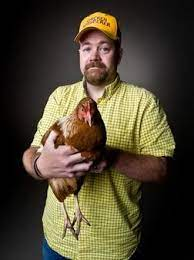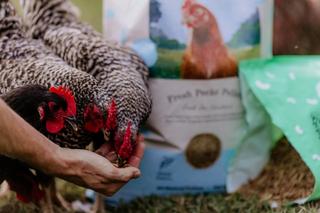Brooder Basics


A brooder is the baby chick’s home for the first few weeks of its life and will provide everything the hen does for her offspring after they hatch. The five main items needed for an effective set up are the brooder, bedding, waterer, feeder, and a heat source.
There are many different types available. You can build one yourself using anything from a cardboard box to a plastic storage bin, or you can choose to purchase one of the many different types available at retail outlets.

Brooders
One of the most user-friendly brooders I’ve tried is the GQF Universal Box Brooder. It isn’t cheap at $238, but it’s a great choice if you plan on hatching a lot of chicks.
My second favorite set up is build-your-own and I’ve encouraged plenty of people to start out this way. All you need is a 40-gallon plastic bin, one-gallon chick waterer, one-quart chick feeder, a bale of pine shavings, and a heat source.
Just right
Many reliable sources recommend keeping the brooder at 95°F for the first week, then reducing the temp by 5°F each week thereafter until the chicks are fully feathered out. If you go this route, be sure to place the thermometer at “chick-level” to gauge the temperature they experience—hanging the thermometer on the rim of the brooder won’t help. While the above is a good guide, I’ve never felt the need to add a thermometer—if you watch your chicks closely, you can tell if they are comfortable or not using the “Goldilocks” method: If they’re all huddled together under the heat source and are chirping so loudly you can’t think straight, they’re too cold. Lower the heat source or increase the wattage of the bulb. If the chicks are lethargic—or even panting—and gathered in the corner farthest from the heat source, they’re likely too hot. Raise the heat source or decrease the bulb’s wattage. If you peek into the brooder and all of the chicks are wandering around and sounding contented chirps, then the temperature is probably just right. TIP: An elongated brooder gives chicks the leeway to move closer or farther away from the heat source to maintain their personal comfort level.
Bedding
The two most popular bedding options are pine and aspen shavings. While there are no studies that show cedar shavings are harmful to baby chicks, some studies show they can harm other small animals. Cedar shavings release a toxin that enters into the blood stream when inhaled. This prompts the liver to work harder to remove the toxin with the animal ultimately dying of liver failure—I don’t take the chance when there are other choices available.
Waterer and feeder
Your baby chicks will need a constant supply of fresh water and feed. Because most brooders are smaller than coops, smaller feeders and waterers work best—I prefer one-gallon waterers and one-quart feeders. Try adding some marbles in the bottom of the waterer to attract the chicks to the waterer, prevent them from wading in, and even help prevent drowning.
Depending on how high the sides of your brooder are, you can expect the baby chicks to attempt flying out as early as seven-days old. They start off by flying on top of the waterer or feeder, fly up to the rim of the brooder, and then out of the brooder and onto the floor.
You can stop this by taping or gluing an inexpensive plastic funnel to the top of both the waterer and feeder to keep the chicks from landing. This will also block them from roosting on top and pooping in their feed and water.
To prevent the chicks from flying out altogether, consider poultry netting or folding chicken wire across the top of the brooder. This will not only prevent the chicks from flying out, but it will also discourage the house cat from having a quick snack while you’re away at work.
Heat source
The heat source you choose is very important. While there don’t seem to be as many fires in the spring caused by improperly-heated brooders as there are coop fires in the winter, fires can and do happen. If you must use a heat lamp, secure it using fail-safe measures.
My list of recommended—and safe�—brooder heaters includes the EcoGlo 20 from Brinsea Products and the Sweeter Heater from Infratherm. Another plus is they provide heat with no additional light.

Other considerations
Pasty butt
Pasty butt is a condition where feces sticks and hardens on the chick’s vent and prevents it from eliminating waste. Not all of your baby chicks will have this condition, but I’ve noticed that the same three or four chicks that have it today will probably still will have it tomorrow when you check them again.
Fortunately, the solution is simple: Just take a warm moist paper towel and wipe the feces away just like you would a baby. More good news: This condition usually goes away within three to four weeks.
Chick starter
The required feed for the brooder is chick starter. As with water, you want to have a constant supply of feed in the brooder at all times. There will be a considerable amount of waste the first week, but as the chicks grow, you can raise the feeder and waterer by either hanging them or placing something under them depending on what kind of feeder and waterer you have.
Dip beaks
If you purchase day-old chicks from a hatchery and have them mailed to you, the first thing you want to do when they arrive at the post office is open the shipping container and see if there are any dead on arrival. I’ve had thousands of baby chicks shipped to me over the years and had very few not make the trip. If you do have any dead on arrival, there is a special claim form to fill out before leaving the post office—most hatcheries are happy to make good on those that didn’t survive.
Once back home, take the baby chicks out of the shipping container one by one and check for any sick or lethargic chicks as well as any deformities. These chicks will need to be placed in a separate “ICU” brooder for specialized attention and care.
Then, you should dip the chick’s beak in the water trough and allow it to tilt its head back and drink down some water. Next, dip the chick’s beak in the feeder and allow it to eat a few crumbles. I like to do this because you are essentially playing the role of the mama hen and showing the baby chick its food and water source for the next few weeks.
Cleaning
Your nose will tell you how often you need to clean the brooder. Depending on how many chicks you have, you may only have to clean it once every few days starting off. But as the chicks grow, you will need to clean more often—possibly daily. Remember, a clean brooder can go a long way toward preventing disease, but some scientists claim that a brooder that is too clean may not allow the chick’s natural immune system to develop and do its job.
Depending on the season and where you live, your baby chicks will probably live in the brooder for the first six to eight weeks. Even so, if the temperature outside is pleasant, supervised visits in the backyard a few minutes each day is fine. Once they are fully feathered, they will be ready to make their way outside to either a starter coop or their new permanent home.
If you are adding new chicks to an existing flock, it’s important to wait until they are about the same size as your current flock to prevent the older, more mature chickens from pecking and bullying the little ones. You should also refrain from giving any treats for the first four to six weeks so the chick’s digestive system can fully develop.
I’m sure which ever brooder you choose, you will have a fun and rewarding experience.
Until next time,
Power to the Poultry!
About the author
Andy Schneider, aka The Chicken Whisperer,, hosts the popular podcast Backyard Poultry with the Chicken Whisperer and has authored [I]The Chicken Whisperer’s Guide to Keeping Chickens.[I]Andy is also the national spokesperson for the USDA-APHIS Biosecurity for Birds program.
Tags:Chicken Scratch

Chicken Whisperer is part of the Catalyst Communications Network publication family.













